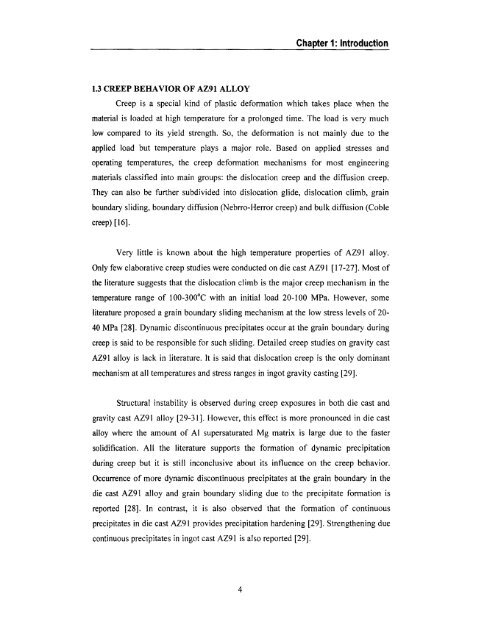“Influence of Si, Sb and Sr Additions on the Microstructure ...
“Influence of Si, Sb and Sr Additions on the Microstructure ...
“Influence of Si, Sb and Sr Additions on the Microstructure ...
You also want an ePaper? Increase the reach of your titles
YUMPU automatically turns print PDFs into web optimized ePapers that Google loves.
1.3 CREEP BEHAVIOR OF AZ91 ALLOY<br />
Chapter 1: Introducti<strong>on</strong><br />
Creep is a special kind <str<strong>on</strong>g>of</str<strong>on</strong>g> plastic deformati<strong>on</strong> which takes place when <strong>the</strong><br />
material is loaded at high temperature for a prol<strong>on</strong>ged time. The load is very much<br />
low compared to its yield strength. So, <strong>the</strong> deformati<strong>on</strong> is not mainly due to <strong>the</strong><br />
applied load but temperature plays a major role. Based <strong>on</strong> applied stresses <str<strong>on</strong>g>and</str<strong>on</strong>g><br />
operating temperatures, <strong>the</strong> creep deformati<strong>on</strong> mechanisms for most engineering<br />
materials classified into main groups: <strong>the</strong> dislocati<strong>on</strong> creep <str<strong>on</strong>g>and</str<strong>on</strong>g> <strong>the</strong> diffusi<strong>on</strong> creep.<br />
They can also be fur<strong>the</strong>r subdivided into dislocati<strong>on</strong> glide, dislocati<strong>on</strong> climb, grain<br />
boundary sliding, boundary diffusi<strong>on</strong> (Nebrro~Herror creep) <str<strong>on</strong>g>and</str<strong>on</strong>g> bulk diffusi<strong>on</strong> (Coble<br />
creep) [16].<br />
Very little is known about <strong>the</strong> high temperature properties <str<strong>on</strong>g>of</str<strong>on</strong>g> AZ91 alloy.<br />
Only few elaborative creep studies were c<strong>on</strong>ducted <strong>on</strong> die cast AZ9l [17-27]. Most <str<strong>on</strong>g>of</str<strong>on</strong>g><br />
<strong>the</strong> literature suggests that <strong>the</strong> dislocati<strong>on</strong> climb is <strong>the</strong> major creep mechanism in <strong>the</strong><br />
temperature range <str<strong>on</strong>g>of</str<strong>on</strong>g> 100-300°C with an initial load 20-100 MPa. However, some<br />
literature proposed a grain boundary sliding mechanism at <strong>the</strong> low stress levels <str<strong>on</strong>g>of</str<strong>on</strong>g> 20<br />
40 MPa [28]. Dynamic disc<strong>on</strong>tinuous precipitates occur at <strong>the</strong> grain boundary during<br />
creep is said to be resp<strong>on</strong>sible for such sliding. Detailed creep studies <strong>on</strong> gravity cast<br />
AZ91 alloy is lack in literature. lt is said that dislocati<strong>on</strong> creep is <strong>the</strong> <strong>on</strong>ly dominant<br />
mechanism at all temperatures <str<strong>on</strong>g>and</str<strong>on</strong>g> stress ranges in ingot gravity casting [29].<br />
Structural instability is observed during creep exposures in both die cast <str<strong>on</strong>g>and</str<strong>on</strong>g><br />
gravity cast AZ91 alloy [29-31]. However, this effect is more pr<strong>on</strong>ounced in die cast<br />
alloy where <strong>the</strong> amount <str<strong>on</strong>g>of</str<strong>on</strong>g> Al supersaturated Mg matrix is large due to <strong>the</strong> faster<br />
solidificati<strong>on</strong>. All <strong>the</strong> literature supports <strong>the</strong> formati<strong>on</strong> <str<strong>on</strong>g>of</str<strong>on</strong>g> dynamic precipitati<strong>on</strong><br />
during creep but it is still inc<strong>on</strong>clusive about its influence <strong>on</strong> <strong>the</strong> creep behavior.<br />
Occurrence <str<strong>on</strong>g>of</str<strong>on</strong>g> more dynamic disc<strong>on</strong>tinuous precipitates at <strong>the</strong> grain boundary in <strong>the</strong><br />
die cast AZ91 alloy <str<strong>on</strong>g>and</str<strong>on</strong>g> grain boundary sliding due to <strong>the</strong> precipitate formati<strong>on</strong> is<br />
reported [28]. In c<strong>on</strong>trast, it is also observed that <strong>the</strong> formati<strong>on</strong> <str<strong>on</strong>g>of</str<strong>on</strong>g> c<strong>on</strong>tinuous<br />
precipitates in die cast AZ91 provides precipitati<strong>on</strong> hardening [29]. Streng<strong>the</strong>ning due<br />
c<strong>on</strong>tinuous precipitates in ingot cast AZ91 is also reported [29].<br />
4
















